SNL has officially returned, celebrating its 50th year on the air. Since its start in 1975, the show has introduced Americans to classic comedy skits, ranging from Wayne’s World to the Blues Brothers. On top of that, comedy icons like Eddie Murphy, Adam Sandler, and countless others have SNL to thank for launching their careers. But let’s not forget an often overlooked part of SNL’s history: its musical guests.
To celebrate SNL’s 50th anniversary, let’s take a look back at 50 classic performances from throughout the show’s history. In this installment, we’ll travel back to SNL of the 1980s to see some of the decade-defining acts that grace the 30 Rockefeller Plaza stage.
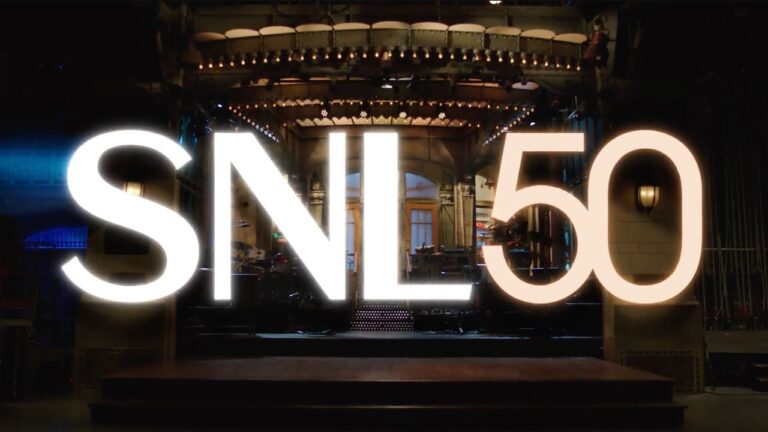
The B-52’s (1/26/1980)
To kick off the 1980s, New Wave icons the B-52’s performed an energetic set. Hailing from the college town of Athens, Georgia, the band was riding high after the release of their debut self-titled album. So in January, 1980, they made the trek up to New York City to soundtrack an episode hosted by the late-actress Teri Garr.
To start off their set, the band played their biggest hit at the time – “Rock Lobster.” Before the music even started, nothing stood out more than the band’s style. Their eclectic eighties meets fifties fashion was on full display. Cindy Wilson and Kate Pierson’s mile-high beehive haircuts instantly gave the audience a taste of the B-52’s ethos. They were deeply rooted in retro aesthetics, but also spearheading a New Wave of punk.

The audience did not have much time to gawk at the band’s style, because Ricky Wilson immediately fired into the iconic “Rock Lobster” riff. Alongside guitar, singer Fred Schneider played SNL’s favorite instrument – the cowbell. Throughout the song, Schneider bopped around the stage, waving his cowbell and drumstick. This dance party of a song dramatically halted at the bridge, with the band members collapsing as Schneider yells “Down! Down!” Following this, the band immediately sprung back up, whirling around the stage. Even Keyboardist Kate Pierson left her station to join in on the vortex. The B-52’s, unlike any band from that era, matched campy theatrics with a rough punk edge.
Following a number of skits, the band returned to play “Dance This Mess Around.” This track started off much differently than their opener, with harsh keyboard stabs and dissonant guitar. For this number, Schneider passed off vocals to Cindy Wilson. Her soft vocals grew into screaming as the chorus neared, with Schenider’s distinctive yelping backing joining in soon after. Throughout the song, the band all erratically danced, while somehow remaining unsettlingly still, mirroring their SNL predecessor Devo.
With this performance, the B-52’s both carried on history, and made history of their own. They brought the 1970s New Wave of Devo and Elvis Costello to a new decade. This performance, while unassuming at the time, hinted at a decade that both New Wave and the B-52s would thrive in.
Funky 4+1 (2/14/1981)
In 1981, a Bronx-based quintet made SNL history with a single performance. On Valentine’s Day, Funky 4 +1 played the first Hip-hop performance, not only on SNL, but on all of national television.
Known hip-hop aficionado Debby Harry hosted that night, and personally vouched for the band. During her work with Blondie, Harry formed a great appreciation for hip-hop. In 1981, Blondie made history with “Rapture,” becoming the first song with a rap verse to reach number one. As part of this, Harry became close friends with rap icon Fab 5 Freddy, who introduced her to Funky 4 +1.
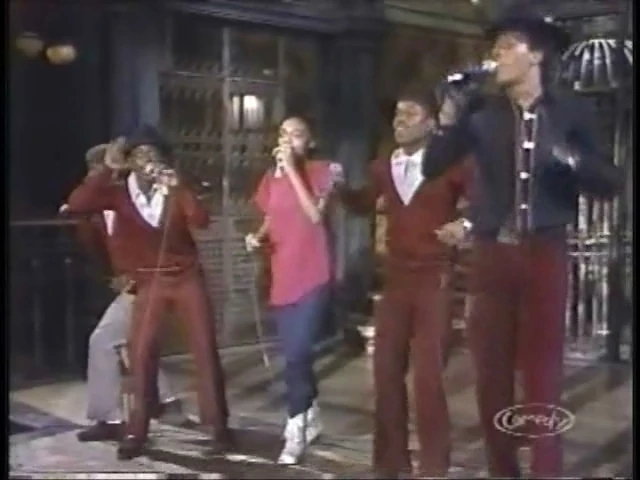
From the first second of their SNL performance, “That’s the Joint” was a straight blast of joy. The Funky 4 all in matching red sweaters accentuate their female lead Sha-Rock. In a way, the monochrome male backers and the standout female lead vocalist wasn’t too different from Blondie itself. A sample of “Rescue Me” by A Taste of Honey propels the song forward with funky bass and horns. Over this disco beat, the five rappers pass off lines between each other, making for a great early hip-hop track.
One key member of the band wasn’t even a member, but rather a DJ. Throughout the performance, he can be seen spinning records in front of the group. This sampling-based number marks a radical shift in the style of musical performances on SNL, foregoing live instrumentation altogether. This showing also revolutionized how rap artists performed live. Rather than bopping to the beat, the band adopted fully choreographed synchronized dance moves. Drawing from older Motown acts, the band looked more akin to the Jackson 5 than the Sugarhill Gang on stage.
Prince (2/21/1981)
Only one week after Funky 4 + 1, SNL introduced a future superstar to the world. Prince, the artist formerly known as Prince, or Ƭ̵̬̊, whatever you want to call him, he made his special debut appearance on February 21st, 1981. While not the musical guest – that was rock icon Todd Rundgren – SNL invited Prince to perform one song from Dirty Mind. This performance marked the first of four guest slots Prince filled during his life.
Following two performances by Rundgren, it was Prince’s turn to perform “Partyup.” Prince and his band emerged on stage in matching trench coats. Under his trench coat, Prince wore only a bandana, short-shorts, and stockings, mirroring the cover of Dirty Mind. The performance got off to an energetic start, driven by funky synths, bass, and guitars. Throughout the funk number, Prince’s iconic falsetto vocals soared. However, one vocal line also caused controversy. Some claimed Prince sang the original lyric “Fighting war is such a f*cking bore,” violating broadcasting regulations. Prince himself, however, claims he said “Freakin.”
Funnily enough, yet another F-bomb overshadowed this performance, this time coming from cast member Charles Rocket. During the farewell, Rocket, parodying JR from Dallas, angered TV censors yet again. Turning to the camera he said “Oh man, it’s the first time I’ve ever been shot in my life. I’d like to know who f*ckin’ did it.” Needless to say, the cast and broadcast staff were all shocked, and Michaels promptly fired Rocket. This, however, was the last time anyone outshined Prince, as he would go on to dominate for the rest of the eighties.
This performance is sadly near impossible to find in its entirety online. Whether due to the multiple swears, or Prince’s estate’s strict licensing policy is unsure. It is a shame, as it is one of the best to ever grace 30 Rock. Immediately after, Jeffrey Doumanian writing for Rolling Stone said, “I was blown away, he was just the most original act I had seen in a long time.
FEAR (10/31/1981)
For one night only, the SNL stage transformed into a no-holds-bar mosh pit. That night was Halloween of 1981, when Lorne Michaels invited LA-based hardcore band FEAR onto the program. With his previous bad luck with punks *cough, cough, Elvis Costello* why would Michaels push his luck with an even rowdier crowd? The answer is pretty simple: he didn’t. In fact, it was SNL alum and notorious party animal John Belushi who pitched the idea.
John Belushi was an avid fan of all things punk rock, quickly becoming close friends with FEAR. Earlier that year, he even offered the band the opportunity to soundtrack his movie Neighbors. The studio, however, was not impressed and thought the band’s music was highly inappropriate. Belushi, being the good friend he was, offered FEAR a musical slot on SNL to make up.

Belushi’s plan, however, was much more complex than just having the band perform. He pitched Michaels his idea – to turn 30 Rock into a full-fledged punk venue with slam dancers. Then, Belushi began making calls to punks across New York and Washington DC. By Halloween night, 40 punks closed in on the SNL studio, including future Minor Threat singer Ian Mackaye. For the dress rehearsal, the punks mellowed out, lulling Michaels into a false sense of security. But when have punks ever been ones to follow the rules?
When FEAR took the stage that night, all hell broke loose. They began with “Beef Bologna,” a breakneck pace hardcore track with screamed vocals and fiery guitars. As soon as the music began, the punks in the audience showed what they were really made of. Some dove across the camera, others stormed the stage, and all of them indulged in the pure chaos. As singer Lee Ving recalled, “The real audience at Saturday Night Live was scared to death.” Luckily for everyone at 30 Rock, after the relatively short song, the crowd seemed to calm down slightly.
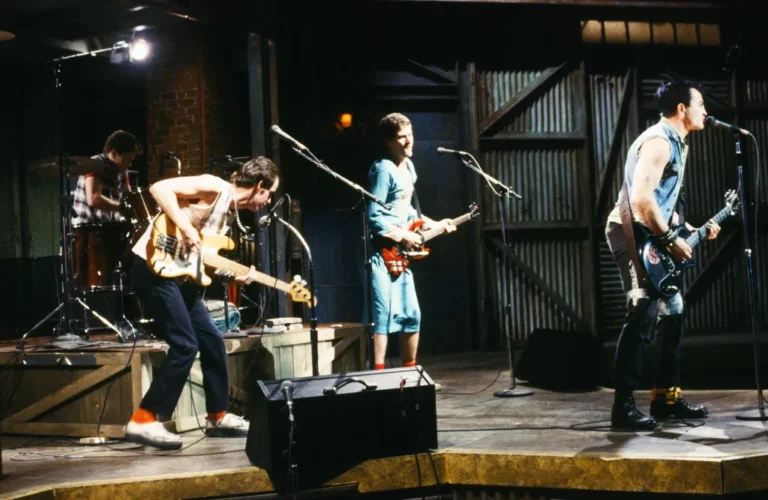
It wouldn’t last. Ving – the comedian he is – grabbed the mic and said, “It’s very nice to be here in New Jersey,” warranting immediate boos. This segued into their second track “New York’s Alright if You Like Saxophones.” Sonically, this song is unique among eighties hardcore, featuring dissonant saxophone at its center. The audience couldn’t savor this musical complexity, as not even two seconds into the song, the moshing resumed. In the mayhem, the mic even fell into the audience. The young DC-raised Ian Mackaye seized on this opportunity, yelling “New York Sucks,” starting a small fight.
The band’s final track was “Let’s Start a War,” which seemed like a good reflection on what they were doing in the studio. Unfortunately for FEAR, they did not have the chance to finish this performance. In fact, they didn’t even get 15 seconds in. From stage right, a man entered holding a massive pumpkin. Lumbering across the stage, he then chucked it directly at producer Dick Ebersol’s chest. In a panic, SNL cut to dead air for the first time in its history. After some hesitation, the broadcast resumed with a pre-recorded Eddie Murphy skit. As audiences watched on, cops chased the 40 punks out of the studio, restoring order to 30 Rock. Needless to say, Lorne Michaels never invited FEAR back to SNL.
Queen (9/25/1982)
SNL’s eighth season began with a performance by one of the biggest legends in rock: Queen. With SNL alum Chevy Chase hosting, the band joined to perform two songs from their 80s discography. This should have been an easy slam dunk: iconic host, equally iconic band, how could it go wrong? The issue came with Queen’s touring schedule. The SNL premiere came on the back of a 27-city US tour. The band were all exhausted, and Freddy Mercury’s booming voice was shot. Queen, however, were never a band to shy away from a challenge, and persevered. Playing sped up, more rock-edged versions of their tracks, they stunned the audience.
The first track they performed was #1 hit “Crazy Little Thing Called Love.” This performance was a much more beefed-up rock version of the hit. It began with Mercury front-and-center, surprisingly playing the acoustic guitar. Maybe it was because of his vocal limitations, or the need for the song’s iconic riff, Mercury ditched the keyboard for the guitar. Once the song started, honky tonk pianos and a jazzy electric guitar riff from Brian May joined in. Listening to the performance, you couldn’t even tell Mercury’s voice was all but destroyed from a month of touring. To close out the track, May laid down a legendary extended electric guitar solo.
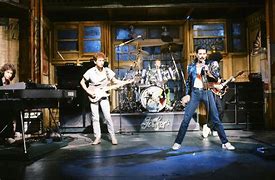
Later in the episode, Queen returned to the stage to perform “Under Pressure.” Although their latest album Hot Space was a commercial disappointment, its lead single – a debut with David Bowie – was an instant classic. Prior to Mercury’s passing in 1991, “Under Pressure” was a sole Queen live track – with or without Bowie. Beginning with the song’s iconic bassline, everything started according to plan. However, when Mercury’s vocals begin, his exhaustion was much more noticeable. There was no way he would be able to hit the song’s rising vocal lines. As a result, he had to alter the melodies, allowing his more limited register to boom through the studio. Throughout the song, he confidently strutted across the stage in a leather jacket. It was clear that his voice didn’t phase him in the slightest.
This performance marks a sad moment in music history. SNL was the final performance the band ever played in the US prior to Mercury’s passing from AIDS 9 years later. Even though it was their final American show, and the band were clearly not at their highest, it was a clear show of force. They may have been exhausted and had no voice, but their musical prowess and stage presence made all of that unimportant. Watching the performance, there is no question why Queen was one of the greatest bands to ever do it.
The Replacements (1/18/1986)
Yet another punk band banned from SNL for disorderly behavior – I guess third times a charm. This story, much like Elvis Costello, began with a last-minute fill in by Lorne Michaels. Originally, SNL booked the Pointer Sisters to perform on a Harry Dean Stanton hosted episode. However, when they canceled, Lorne Michaels called in Minnesota-based alternative band The Replacements.
Riding on the success of their major label debut Tim, the Replacements’ SNL performance was a medium to prove themselves on a live stage. What better way to prepare for such a momentous occasion than partying like there’s no tomorrow. Leading up to the performance, the band made a day of binge-drinking with Harry Dean Stanton. And did they drink…and drink…and drink. When it came time to go up on stage, guitarist Bob Stinson tripped and fell, smashing his guitar.
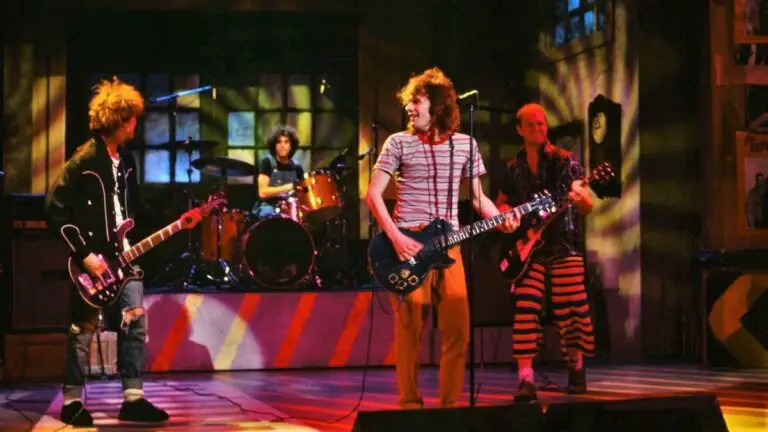
Once a replacement guitar was given to the Replacements, they took the stage for their first song. From the first second of “Bastards of Young,” it was clear something was off. It seemed like each band member was playing in a different key. In other words, their drinking had caught up to them and the performance was a mess. Clearly, the band was already at odds with Lorne Michaels, poking fun at him during the performance. As Paul Westerberg sang, “The ones who love us least are the ones we’ll die to please,” he gave a big exaggerated wink right in Michaels’ direction.
The real trouble came right after this. Westerberg was worried that Stinson was so intoxicated that he would miss his cue for the song’s guitar solo. Taking action into his own hands, Westerberg yelled, “Come on f*cker” to cue Stinson himself. Michaels was furious, fearing backlash from network censors for this use of profanity.

Michaels, however, did let the Replacements take the stage for another song. When the band reemerged, they seemed to have swapped outfits with each other for some reason. Maybe it was the outfit change, or the extra time to sober up, but their performance of “Kiss Me on the Bus” was much more composed. The band played together, in tune, and in key. When the moment of truth came for Stinson to play his solo, he was even able to do so without any swearing needed.
This cleanup job was not enough to quell Michael’s anger however. By the time the Replacements left the stage, Michaels had banned them. For the third time in SNL’s history, a punk act’s hijinx had gotten them banned from the show. Singer Paul Westerberg, however, was allowed to return to the show seven years later as a solo act. During this performance, he even played a Replacements track – “Can’t Hardly Wait.” The band’s next performance at 30 Rock wasn’t until a 2014 appearance on Jimmy Fallon – a whopping 32 years later.
Phillip Glass (3/22/1986)
Who screams SNL musical guest more than pianist and experimental composer Phillip Glass? If you thought literally anybody else, you’d most likely be correct. However, for one special episode of SNL, Glass performed and soundtracked the whole night. This decision, while odd at first glance, makes much more sense in the greater context of the unique episode it soundtracked.
On March 22nd, 1986, filmmaker Francis Ford Coppola hosted alongside comedian George Wendt. This episode, unlike SNL’s normal skit-based format, this night had an overarching narrative arc. It followed Coppola in his quest for an Emmy award. To do this, he directed the entire episode, repeatedly misunderstanding and twisting SNL’s concept to make it more artful. This vision was put on display immediately after the cold open. In place of the show’s fun intro was a moody opening credits sequence. Glass’s track “Facades” from Glassworks substituted the usual upbeat jazz theme.

After this, the show’s skits doubled down on its concept. First came Wendt’s monologue, which Coppola repeatedly interrupted hoping to capture the perfect take. To add onto this, he even told the audience how they should laugh in response. Following the monologue was a number of experimental, esoteric, and realist sketches tackling everything from Vietnam to The Honeymooners. Coppola even recorded a number of satirical commercials to make sure every aspect of the broadcast was up to his standards.
Throughout this experiment in television broadcasting, Coppola invited the Phillip Glass Ensemble to perform twice. The first of these was “Lightning” from Glass’s 1986 album Songs from Liquid Days. This track was unlike anything 30 Rock had witnessed previously. In Glass’s normal fashion, repetitive whirling percussion and winds propelled the song forward. Minor-key keyboard stabs supplemented this, creating an almost alien atmosphere. At the center of the piece was Janis Pendarvis’ beautiful operatic vocals, performing lyrics by Suzanne Vega. This track marked one of the most accessible moments in Glass’s discography, while remaining musically complex.

Glass’s second performance was “Rubric,” an excerpt from his 1982 classical opus Glassworks. This track was much more abstract than its predecessor. Keyboard and woodwind arpeggios drove the song forward. This song was much more emblematic of Glass’s discography, being a repetitive, deeply-minimalist composition. As it went on, it grew more and more lush, adding operatic vocals on top of the mix. As the ensemble performed, clips from the experimental documentary Koyaanisqatsi overlaid the show. The excerpts, featuring nighttime timelapses of a city, only added to the monumental aura of the performance.
Due to the unorthodox one-off nature of this episode, it is unlikely that 30 Rock will witness anything else like it again. It really is too bad, as the Phillip Glass Ensemble’s appearance was one for the ages. Equal parts experimental and approachable, minimalist and lush, the performance bent the rules of what an SNL performance could really entail.
Elvis Costello (3/25/1989)
So far, Lorne Michaels has not shied away from banning anyone he disagreed with. Play a song he didn’t like – banned. Said a naughty word on air – really banned. However, on March 25th, 1989, Michaels felt in a much more forgiving mood. After a 12 year ban, SNL invited back New Wave icon Elvis Costello for a solo performance.
12 years prior, Elvis Costello and the Attractions received a “lifetime” ban for going off script. Instead of playing “Less than Zero” like planned, Costello switched into a rendition of “Radio, Radio,” which angered Michaels beyond belief. Now a solo artist, Costello returned to support his hit album Spike, playing two new songs.

In the leadup to Costello’s first song, host Mary Tyler Moore made one of the strangest performance announcements in the history of SNL. Continuing a streak of raunchy language, she told the audience “Elvis Costello’s penis is here tonight, so stick around, we’ll be right back.” After that strange introduction, Costello took the stage to perform top-20 hit “Veronica.” Co-written by Paul McCartney, the song was an upbeat pop-rock number, lacking Costello’s punk edge that got him in hot water during his first appearance. Picking up an acoustic guitar, Costello led the band, singing about a woman slowly losing her memories with old age. Despite the sad lyrics of the song, you would have no idea based on Costello’s lively energy.
Following this, Costello returned to perform “Let Him Dangle.” This track is noticeably more solemn than his opener, discussing a man preparing for the gallows. The mostly acoustic track provided a comedown from the frenetic energy of “Veronica.” Despite the more serious nature of Costello’s tracks that night, he managed to stay in Michaels’ good graces. All it took was Costello staying on script. This forgiveness appears to have lasted, with Costello making two additional guest appearances throughout the 1990s.
On top of this performance, the episode was also notable for its sketches. Following Costello’s second song, SNL debuted a new sketch. Featuring Mike Myers and Dana Carvey, it introduced the world to the Wayne’s World public access television show. The charming sketch, featuring the two loveable music nerds in Wayne’s basement, quickly became a fan-favorite. Within just four years, it became a recurring sketch, spawned two movies, and got an entire generation saying “Wayne’s World, Wayne’s World. Party time! Excellent!” This one unassuming episode not only mended SNL’s past conflicts, but also paved the way to its future.
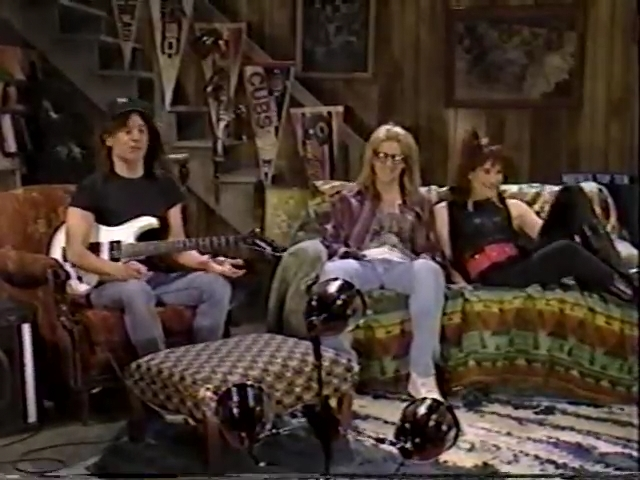
Tom Petty (5/20/1989)
In 1989, Tom Petty arrived at 30 Rock for his third appearance on SNL. This episode, hosted by Steve Martin, however, marked Petty’s first time without the Heartbreakers backing band. His solo SNL debut was also preceded by tragedy. That night, SNL original cast member Gilda Radner passed away following a battle with ovarian cancer. In response, Petty made his performance a tribute to the legendary comedian
Petty’s first song was “Runnin’ Down a Dream.” Starting with its iconic descending riff, the song quickly jumped into an upbeat rock groove. With chugging guitars and Petty’s soft vocals, the song lilted along for a really fun two minute stretch. After this, the song erupted into a fiery guitar solo from Mike Campbell to close it out. With this amped up shredding over his usual heartland rock, Petty entered his solo career with a bang.
Prior to the episode, Petty had planned to play his hit “I Won’t Back Down,” to close his set. However, as Saturday approached, he felt it did not fit the mood of the night. Instead, he opted to play a yet-unreleased track off his new album Full Moon Fever. This track was the future megahit “Free Fallin’.” Originally, his label was unconvinced, wanting him to play his tried and tested current hit. In response, Petty told them that “Free Fallin’” was actually the late Radner’s favorite song, so they relented.
This SNL episode marked the first live performance of what many consider Petty’s signature song. Unlike the album cut, this live performance featured much more lush instrumentation, mirroring a wall of sound. In place of acoustic guitar is an immensely reverberated electric one. With synth strings, piano, and reverb vocals, the song echoed like Petty was performing in a cathedral. Aiding in this feeling were the Renaissance paintings surrounding the band on stage. To end this beautiful performance, Petty decided to make things a little awkward. As the song ended, he went to hug Howie Epstein who did not seem interested. So, they both just buffered in place awkwardly until the camera faded.
In this performance, Petty took a somber occasion and made it a celebration of life. In doing so, he not only introduced audiences to his new hit, but also his new path forward as a solo artist. Following this performance, Petty returned to 30 Rock a whopping five times as a musical guest.
Neil Young (9/30/1989)
To close out the 1980s, Lorne Michaels finally caught his white whale. For the past 10 years, SNL attempted to nab Neil Young as a musical guest. The first time they tried, SNL ended up stuck with weirdo new wavers Devo. Finally, the folk legend was in the building to perform a three song set.
At the time of this performance, Young was far from young. At the ripe age of 43, Young was still at the top of his game. When he entered 30 Rock, he sported an Elvis t-shirt, leather jacket, patched up jeans, and maple leafs gears. This outfit was equal parts cool and puzzling, but one thing for sure was that it was 100% Neil Young. In his three decades performing, Young had built up a routine for putting on amazing live shows, saving the upbeat rockers for last. After hours of building up adrenaline and intensity, he would rip out fiery guitar solos like they were nothing. For SNL he had to reach this intensity level instantly. To do this, he took up an intense training regimen, including weightlifting and calisthenics. This training paid off, as Young went on to unleash one of if not the greatest SNL performance ever.
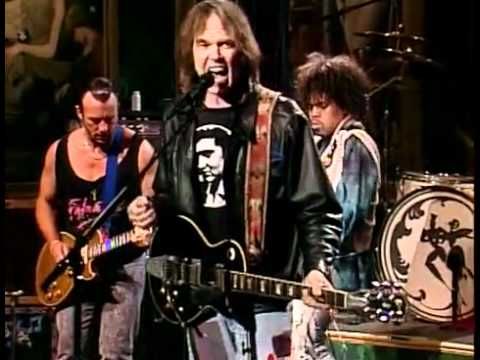
Young’s first song was his newest hit “Rockin’ in the Free World” from 1989’s Freedom. The track kicked off with its iconic chugging guitar riff imbued with fiery distortion. As Young’s lyrics entered, they only added to the sonic intensity. The lyrics initially seem patriotic, referencing the “colors on the street, red, white, and blue.” As the song continued, Young’s lyrics transformed into an indictment of HW Bush-era America as fiery as its guitar tone. With lyrics attacking everything from drug addiction, pollution, and gun violence, the song was a scathing criticism of the US. As the song continued, Young stomped and headbanged across the stage, before erupting into a legendary guitar solo. While firing out metallic guitar bends, Young jumped on the drum kit and crashed into his bandmates. Apparently, Young’s training regimen worked, with the performance having the intensity of a grunge concert.
Following this incendiary performance, Young returned with a much more somber song. The solo acoustic rendition of “The Needle and the Damage Done” worked as a much needed comedown from the explosive energy of Young’s opener. Upon retaking the stage, Young received immediate applause. The song’s lyrics tackled the issues of heroin addiction and the overdose of Young’s Crazy Horse bandmate Danny Whitten in 1972. Following applause throughout the song, Young swapped out his acoustic guitar for an electric one to begin “No More.”
As Young swapped out his gear, his band rejoined him on stage for this last piece. Young originally wrote this track as a spiritual successor to “The Needle and the Damage Done,” and it continued many of its themes. Throughout the song, Young sang of the difficulty to kick drug addiction, accompanied by bluesy solos. Compared to “Rockin’ in the Free World,” the song was much more mellow, finding a comfortable middle ground with the rest of the set. When Young reached the repeated chorus of “no more,” harsh guitar stabs amped up the track. By the time the track ended, Young made all of Lorne Michaels’s greatest wishes come true. He had finally caught his white whale, and Young’s performance was well worth the decade-long wait.

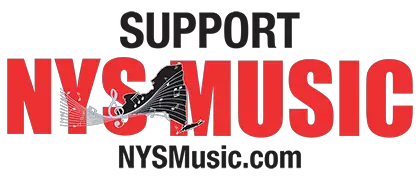
Comments are closed.